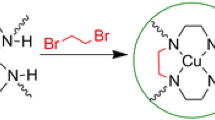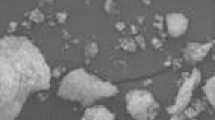Abstract
A new organic–inorganic hybrid sorbent was prepared by a double-imprinting approach for the selective separation of Cu(II) from aqueous solution. In the prepared hierarchically imprinted sorbent, both Cu(II) and surfactant micelles (cetyltrimethylammonium bromide) were used as templates. The sorbent was prepared through self-hydrolysis, self-condensation, and co-condensation of the crosslinking agent (tetraethoxysilane) and the functional precursor (3-aminopropyltrimethoxysilane) in an alkaline media followed by gelation. The adsorption property and selective recognition ability of the sorbents were studied by equilibrium-adsorption method. Results showed that in the presence of Zn(II) the biggest selectivity coefficient of the imprinted sorbents for Cu(II) was over 500, which is much higher than those of non-imprinted sorbents. The largest relative selectivity coefficient (k′) of the ion-imprinted functionalized sorbent between Cu(II) and Zn(II) was over 500. The uptake capacities and the selectivity coefficients of the hierarchically imprinted sorbent were much higher than those of the sorbent prepared without CTAB template. Furthermore, the new imprinted sorbent possessed a fast kinetics for the removal of Cu(II) from aqueous solution with the saturation time less than 10 min, and could be used repeatedly. This sorbent has been successfully applied to the separation and determination of the trace Cu(II) in real water samples and those spiked with standards. This new sorbent can be used as an effective solid-phase extraction material for the highly selective preconcentration and separation of Cu(II) in environmental samples.




Similar content being viewed by others
References
Martin P, Wilson ID, Jones GR (2000) J Chromatogr A 889:143
Haginaka J (2004) Anal Bioanal Chem 379:332
Suedee R, Srichana T, Saelim J, Thavornpibulbut T (1999) Analyst 124:1003
Vlatakis G, Andersson LI, Müller R, Mosbach K (1993) Nature 361:645
Rao TP, Kala R, Daniel S (2006) Anal Chim Acta 578:105
Izatt RM, Bradshaw JS, Bruening RL, Bruening ML (1994) Am Lab 28C-28M
Sreenivasan K (2007) J Mater Sci 42:7575. doi:https://doi.org/10.1007/s10853-007-1625-7
Shamsipur M, Fasihi J, Khanchi A, Hassani R, Alizadeh K, Shamsipur H (2007) Anal Chim Acta 599:294
Dakova I, Karadjova I, Ivanov I, Georgieva V, Evtimova B, Georgiev G (2007) Anal Chim Acta 584:196
Dai S, Burleigh MC, Ju YH, Gao HJ, Lin JS, Pennycook SJ, Barnes CE, Xue ZL (2000) J Am Chem Soc 122:992
Say R, Birlik E, Eröz A, Yilmaz F, Gedikbey T, Denizli A (2003) Anal Chim Acta 480:251
Birlik E, Eröz A, Denizli A, Say R (2006) Anal Chim Acta 565:145
Wang S, Zhang R (2006) Microchim Acta 154:73
Baghel A, Boopathi M, Singh B, Pandey P, Mahato TH, Gutch PK, Sekhar K (2007) Biosens Bioelectron 22:3326
Molochnikov LS, Kovalyova EG, Zagorodni AA, Muhammed M, Sultanov YM, Efendiev AA (2003) Polymer 44:4805
Guo Y, Din B, Liu Y, Chang X, Meng S, Tian M (2004) Anal Chim Acta 504:319
Burba P, Willmer PG (1992) Fresenius J Anal Chem 342:167
Guéguen C, Belin C, Thomas BA, Monna F, Favarger PY, Dominik J (1999) Anal Chim Acta 386:155
Fang GZ, Tan J, Yan XP (2005) Anal Chem 77:1734
Lu YK, Yan XP (2004) Anal Chem 76:453
Acknowledgement
This work was supported by the National Natural Science Foundation of China (No. 20775003).
Author information
Authors and Affiliations
Corresponding author
Rights and permissions
About this article
Cite this article
Wang, Z., Wu, G., Wang, M. et al. An imprinted organic–inorganic hybrid sorbent for selective separation of copper ion from aqueous solution. J Mater Sci 44, 2694–2699 (2009). https://doi.org/10.1007/s10853-009-3353-7
Received:
Accepted:
Published:
Issue Date:
DOI: https://doi.org/10.1007/s10853-009-3353-7




